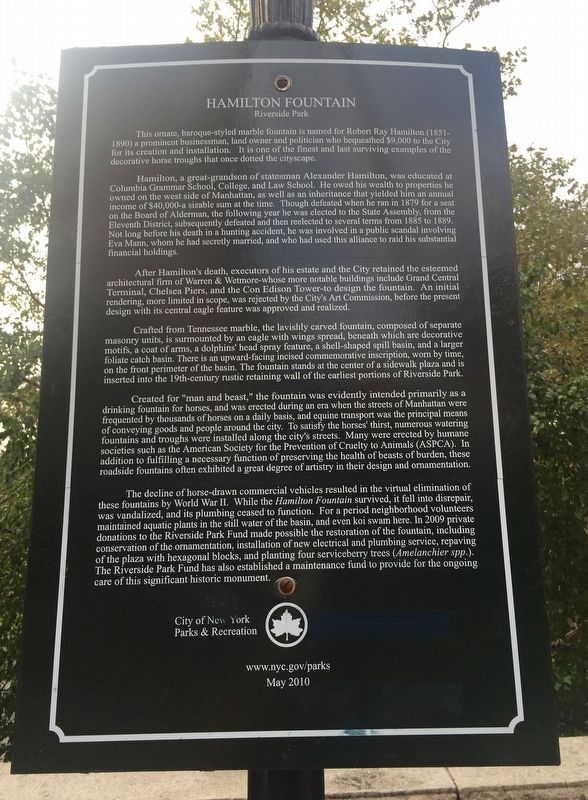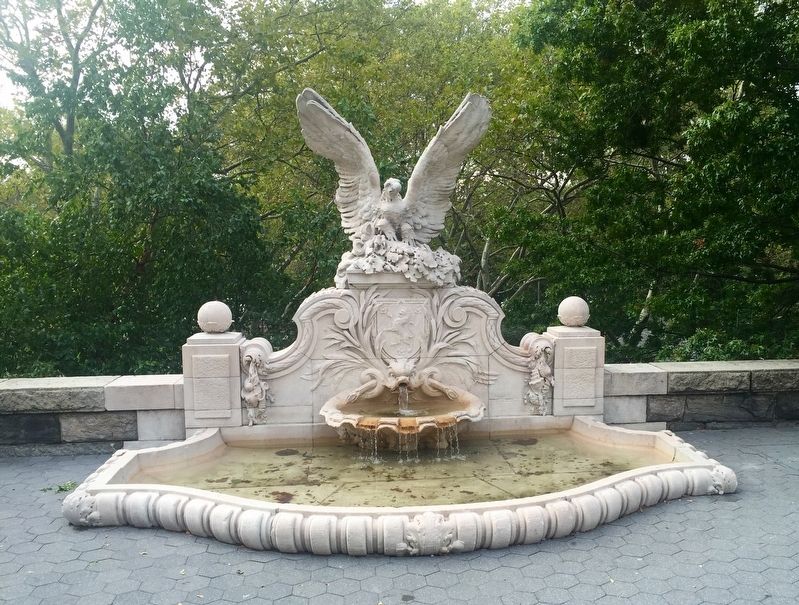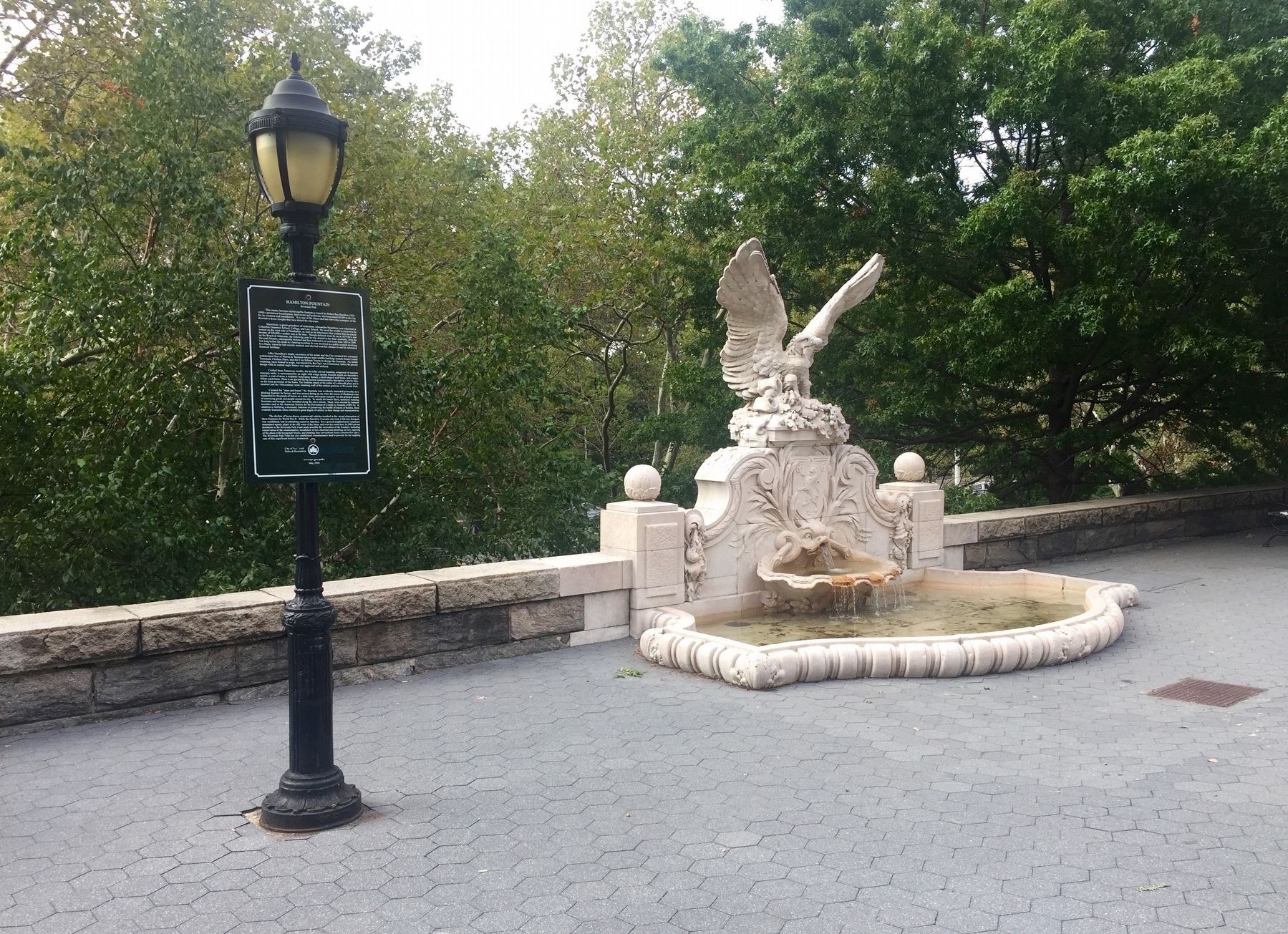Upper West Side in Manhattan in New York County, New York — The American Northeast (Mid-Atlantic)
Hamilton Fountain
Riverside Park
Hamilton, a great-grandson of statesman Alexander Hamilton, was educated at Columbia Grammar School, College, and Law School. He owed his wealth to properties he owned on the west side of Manhattan, as well as an inheritance that yielded him an annual income of $40,000—a sizable sum at the time. Though defeated when he ran in 1879 for a seat on the Board of Alderman, the following year he was elected to the State Assembly, from the Eleventh District, subsequently defeated and then reelected to several terms from 1885 to 1889. Not long before his death in a hunting accident, he was involved in a public scandal involving Eva Mann, whom he had secretly married, and who had used this alliance to raid his substantial financial holdings.
After Hamilton’s death, executors of his estate and the City retained the esteemed architectural firm of Warren & Wetmore—whose more notable buildings include Grand Central Terminal, Chelsea Piers, and the Con Edison Tower—to design the fountain. An initial rendering, more limited in scope, was rejected by the City’s Art Commission, before the present design with its central eagle feature was approved and realized.
Crafted from Tennessee marble, the lavishly carved fountain, composed of separate masonry units, is surmounted by an eagle with wings spread, beneath which are decorative motifs, a coat of arms, a dolphins’ head spray feature, a shell-shaped spill basin, and a larger foliate catch basin. There is an upward-facing incised commemorative inscription, worn by time, on the front perimeter of the basin. The fountain stands at the center of a sidewalk plaza and is inserted into the 19th-century rustic retaining wall of the earliest portions of Riverside Park.
Created for “man and beast,” the fountain was evidently intended primarily as a drinking fountain for horses, and was erected during an era when the streets of Manhattan were frequented by thousands of horses on a daily basis, and equine transport was the principal means of conveying goods and people around the city. To satisfy the horses’ thirst, numerous watering fountains and troughs were installed along the city’s streets. Many were erected by humane societies such as the American Society for the Prevention of Cruelty to Animals (ASPCA). In addition to fulfilling a necessary function of preserving the health of beasts of burden, these roadside fountains often exhibited a great degree of artistry in their design and ornamentation.
The decline of horse-drawn commercial vehicles resulted in the virtual elimination of these fountains by World War II. While the Hamilton Fountain survived, it fell into disrepair, was vandalized, and its plumbing ceased to function. For a period neighborhood volunteers maintained aquatic plants in the still water of the basin, and even koi swam here. In 2009 private donations to the Riverside Park Fund made possible the restoration of the fountain, including conservation of the ornamentation, installation of new electrical and plumbing service, repaving of the plaza with hexagonal blocks, and planting four serviceberry trees (Amelanchier spp.). The Riverside Park Fund has also established a maintenance fund to provide for the ongoing care of this significant historic monument.
Erected 2010 by City of New York Parks & Recreation.
Topics. This historical marker is listed in these topic lists: Arts, Letters, Music • Industry & Commerce. A significant historical year for this entry is 1879.
Location. 40° 46.993′ N, 73° 59.08′ W. Marker is in Manhattan, New York, in New York County. It is in the Upper West Side. Marker is at the intersection of Riverside Drive and West 76th Street, on the left when traveling north on Riverside Drive. Touch for map. Marker is in this post office area: New York NY 10023, United States of America. Touch for directions.
Other nearby markers. At least 8 other markers are within walking distance of this marker. George and Ira Gershwin (about 300 feet away, measured in a direct line); West End Collegiate Church and Collegiate School (about 800 feet away); Anna Eleanor Roosevelt (approx. 0.2 miles away); Riverside Park (approx. 0.2 miles away); Dorothy Parker (approx. ¼ mile away); 246 West End Avenue (approx. ¼ mile away); Septuagesimo Uno (approx. 0.3 miles away); Tecumseh Playground (approx. 0.3 miles away). Touch for a list and map of all markers in Manhattan.
Also see . . . The Hamilton Fountain -- Riverside Drive and 76th Street. "Daytonian in Manhattan" entry. (Submitted on April 10, 2020, by Larry Gertner of New York, New York.)
Credits. This page was last revised on January 31, 2023. It was originally submitted on October 6, 2016, by Andrew Ruppenstein of Lamorinda, California. This page has been viewed 653 times since then and 32 times this year. Photos: 1, 2, 3. submitted on October 6, 2016, by Andrew Ruppenstein of Lamorinda, California.


